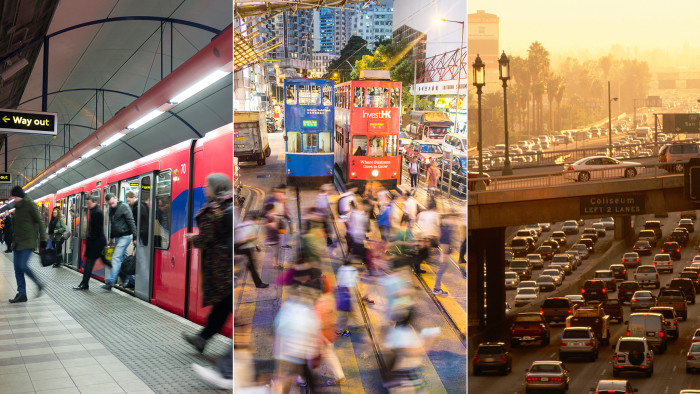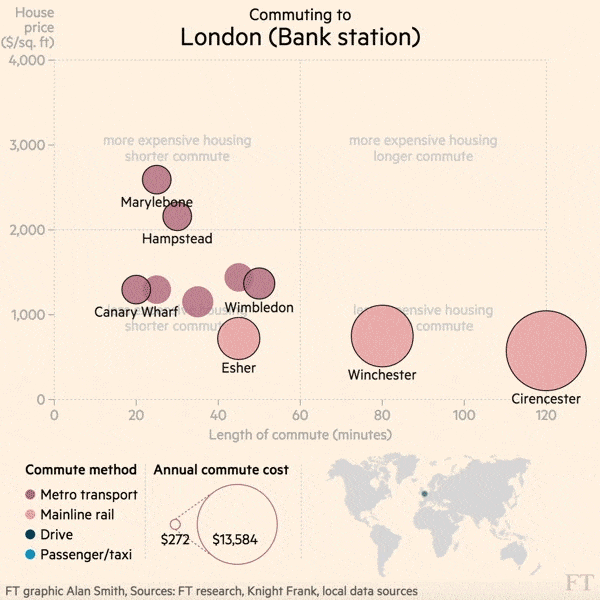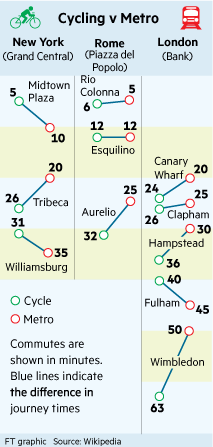Commuting times and housing costs compared in eight major cities

Simply sign up to the Life & Arts myFT Digest -- delivered directly to your inbox.
In Jakarta you will — like as not — be reading this in a traffic jam. As your peers speed through bucolic countryside on their morning rail journey to London you will be crawling through gridlock at about 5.2mph. That is half the speed of an average New York taxi and it won’t be a relaxing drive: the average Jakarta driver stops more than 30,000 times per year.
The fact that you’re not driving may make the journey more bearable — anyone who can afford one in the city has a chauffeur — but you’ll resent the price: the daily commute is the costliest of the eight cities we have surveyed.
Still, plenty of time to wonder at the packet you’ve made on your home (assuming you own it): 150 per cent in five years, according to Knight Frank — growth that dwarfs the competition.
However, as in Los Angeles, new arrivals shouldn’t expect to find bargains on the edge of town: our charts show there is little to be saved in either city by a longer commute.

If you can’t stand the underground and cash is no object, try New York or Hong Kong for a short stroll to the office. In Rome you can bag a (relative) bargain within a short metro journey or — for the brave — cycle ride, but be aware that, with average prime prices down 10.8 per cent since 2011, only Mumbai has seen bigger price falls.
#FTcommute
Send us your personal commuting images and stories on Instagram and Twitter using the hashtag #FTcommute.
We will be sharing some of the best ones at ft.com/ftcommute
Even in London, you needn’t pay through the nose for a home near the office in Clapham, say, or Canary Wharf (in New York, skip over the Williamsburg Bridge for a similar option). At 1.3 per cent in the year to September 2015, property prices in London grew more sluggishly than in any city bar Rome; LA gained 5.8 per cent and Shanghai 10.7 per cent during that time. Yet in some areas big savings are available in return for a few extra moments on a crowded Tube train: eight minutes in one direction on London’s Jubilee line saves you £1m in average house prices, although the deal may lose its lustre when you realise you’re moving from Finchley Road to Wembley Park.
There is nowhere to run to for a saving in Hong Kong. An hour-and-a-quarter from the office, in Sai Kung, homes cost more than $2,500 per sq ft, roughly what you would pay for a pad just 10 minutes’ walk from the office in New York’s Midtown. But at least, as in Shanghai and Rome, your metro journeys are cheap.

Like busy Jakarta, most commutes in Mumbai and LA, are done by car or taxi, and are therefore pricey — and stressful. So, how about two wheels? According to Hasan Pamudji, of Knight Frank in Jakarta, suited executives are increasingly joining the 58 per cent of city commuters who go to work on a motorbike.
To bike or not to bike?
Cycle if you dare in Rome — the city of seven hills, searing summer heat and chaotic traffic is also shot with potholes.
In London you may be a cycling commuter already: more than half a million journeys per day are made by bike, according to Transport for London; at peak times one in four vehicles on some of the city’s busiest roads is a bicycle.
In New York, mayor Bill de Blasio wants to follow London’s lead, aiming for 6 per cent of all trips in the city to be made by bicycle by 2020. Census data show that the current level is 1 per cent.
Photographs: Getty Images
Comments